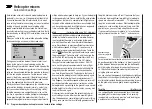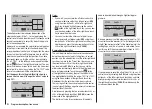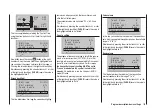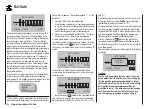
129
Program description: free mixers
“
Transmitter control settings
” menu
I5
I6
I7
+
trv
I8
ctrl 7
free
free
+100% +100%
+100%
+100% +100%
+100% +100%
+100%
free
Note:
If you assign a transmitter control to input 7 and select
two flap servos, input 7 is automatically de-coupled to
avoid possible flap malfunctions.
Start by rotating the transmitter control to its left-hand
end-point, and adjust the landing flap linkages so that
they are in the neutral position at this setting. If you now
turn the knob to the right, the flaps should deflect down;
if they move up, you must reverse the direction of servo
rotation.
Now we turn to the first mixer on the screen on page
127; this is the mixer “6
el”, to which switch 2 has
been assigned:
typ fro
to
M1
M2
M3
c1
el
C1
6
el
el
S
1
2
Touch the central
SET
button of the right-hand touch-key
to open the second screen page:
Mixer ratios and mixer neutral point
Now that we have explained the wide-ranging nature of
the mixer functions, we can move on to the method of
programming linear and non-linear mixer curves.
For each of the three available mixers the mixer curves
are programmed on a second page of the screen dis-
play. Use the arrow buttons
of the left or right-hand
touch-key to select the desired mixer line, use its arrow
buttons to move to the right-hand column (=>), then
touch the central
SET
button of the right-hand touch-key
to switch to the graphic page.
Setting up linear mixer values
In the next section we will describe a typical practical
application, by defining a linear mixer curve intended to
solve the following problem:
We have a powered model with two flap servos connect-
ed to receiver outputs 6
and
7, which were programmed
as “… 2FL” in the “Ail / Flap” line of the “
Base settings
”
menu. These control surfaces are to be employed as
landing flaps, i. e. when the associated transmitter
control is operated, they deflect down only. However, this
flap movement requires an elevator trim correction to
counteract the resultant pitch trim change.
In the “
Transmitter control settings
” menu, assign
the rotary proportional control CTRL 7 to input 6. The
control assigned to input 6 now operates the two servos
connected to receiver outputs 6 and 7 in the standard
way, operating as simple wing flaps.
MIX1
6
el
off
If this display appears, you have not activated the mixer
by operating the assigned external switch - in this case
“2”. To correct this, operate the switch:
MIX1
6
el
trv
0%
0%
0%
offs
ASY
SYM
The full-height vertical line in the graph represents the
current position of the transmitter control assigned to
input 6. (In the above graph this is located at the left-
hand edge because CTRL 7 is at its left-hand end-point,
as already mentioned.) The full-length horizontal line
shows the mixer ratio, which currently has the value of
zero over the whole of stick travel; this means that the
elevator will not “follow” when the flaps are operated.
The first step is to define the offset (mixer neutral point).
To do this press the arrow button
of the left or right-
hand touch-key and move to the “Offs” line:
Summary of Contents for mx-12 Hott
Page 1: ...Programming Manual 33116 mx 16 HoTT 3 en mx 16...
Page 35: ...35 For your notes...
Page 49: ...49 For your notes...
Page 55: ...55 For your notes...
Page 59: ...59 For your notes...
Page 63: ...63 For your notes...
Page 69: ...69 For your notes...
Page 91: ...91 For your notes...
Page 101: ...101 For your notes...
Page 123: ...123 For your notes...
Page 181: ...181 For your notes...
Page 193: ...193 For your notes...
















































